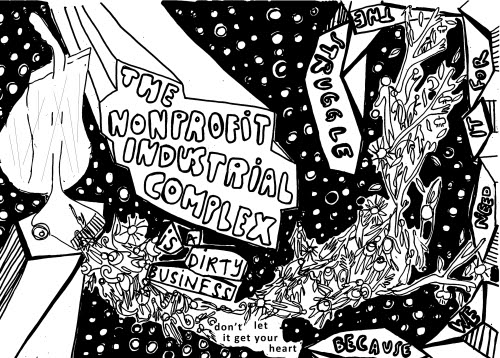In recent years, I have been spending more of my time helping organizations doing work I care about (mostly work to end borders, police and prisons) to build their organizational infrastructure to make it work and prevent conflicts that can tear us apart. In the course of that, we often have conversations about what the organizational culture is like now, its strengths and challenges, and what they want it to be like. This semester, at the end of my Poverty Law class when we were exploring critiques of the non-profit structure and alternatives, I made a little chart to help my students think about the structures of organizations they have been part of, and to stimulate discussion of how we build organizational culture that benefits the work we are trying to do. These days I am enjoying sharing more bits and pieces of early drafts of things and things that may never be further developed here, so here is this thing!

Qualities of Organizational Cultures
|
Aspirational Qualities Reliable, responsible, punctual, follows through |
Challenging Qualities Flakey, late, no follow through, no call back |
|
Welcoming to new people |
Unwelcoming |
|
Flexible, experimental |
Rigid, bureaucratic, formulaic |
|
Collaborative |
Isolationist, competitive |
|
Realistic workload, sustainable, real culture of wellness and care |
Overworking, martyrdom |
|
Direct feedback and growth |
Silence and/or gossip and shit talk |
|
Sticks to values |
Sells out, easily bought off |
|
Humble |
Grandiose (can include taking credit for others’ work) |
|
Sharing work well |
A few people do most of the work |
|
Fun, celebratory, appreciate each other |
Serious, resentful, stressful |
|
Forgiving |
Hold grudges |
|
Able to hold conflict and learn, repair |
Conflict avoidant |
|
Clarity about procedures |
Confusion |
|
Human pace with clear priorities and realistic expectations |
Rushed pace |
|
Transparency |
Secrecy |
|
Generous |
Scarcity, penny-pinching |
Key Values of Democratic Organizations
Transparency and Participation: We all know how decisions are made, how the money comes in and is spent. We can all participate in decisions that are important to us. Smaller delegated decisions are in service to a larger goal or objective that everyone agreed on and smaller teams or individuals are implementing. There are not hierarchies that make some people have more decision-making power and information than others (e.g. Executive Director decides direction of the work alone or decides who to hire and fire and who to pay what in secret).
Accountability: Our priorities come from our principles, and our actions match our priorities. We do what we say we are going to do and for the reasons we say. We are responsive to the communities we say we serve rather than to elites or our funders’ priorities.
Planning and Clarity: We plan ahead and know why we are doing things. We value balance, taking on the right amount of work that we can do well, assessing the most strategic action. We are based in shared values and a shared imagination of liberation, not reactivity.
Other Notes:
- Organizational cultures often reflect the personalities and autopilot behaviors and reactions of the founders. Many of the challenging qualities listed above relate to white, capitalist, and patriarchal norms that undermine democratic participation and mobilization.
- Organizational culture can be changed, and is changed by new people entering, people changing their behaviors, and the context and conditions shifting. We can intentionally change organizational cultures by opening up conversations about an organization’s tendencies and methods, talking about what is working and what is not, reflecting on how own own behavior can match what we want more, influencing each other.
- Real contradictions exist in the above chart. We want to be flexible, and we also want to have a culture of responsiveness, reliability and punctuality. How do we work to cultivate both? Most of us only know a concept of responsibility from dominant culture that is associated with being forced or shamed into being “good,” ignoring our needs, and fearing being punished if we go wrong. How do we hold our values of flexibility, compassion, and justice alongside building a culture where we show up and do what we said we would? These tensions are real, and can be the basis for group conversation and for developing shared practices. If we don’t talk about it, we’ll likely do some automatic reactive behaviors and have different standards that apply to different people, or get frustrated with each other and lose people.
- Each of the elements on the chart has associations that vary in our movements, communities, and orgs. It may be that some groups are closed or secret because it is appropriate for what they are trying to do. However, they may still want to keep asking themselves if they are welcoming and open enough within the parameters of their activities.
